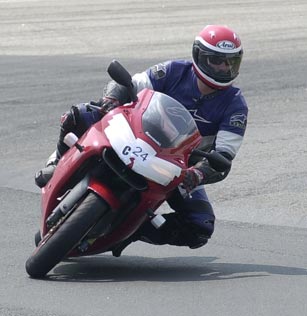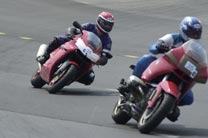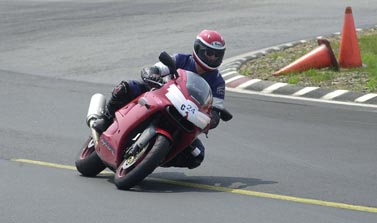|
Penguin Road
Racing School
June 11th and 12th, 2002
New Hampshire International Speedway, Loudon New Hampshire
|
 |
|
NHIS Track Map
|
I recently took the two day street school offered by the Penguin
Road Racing School. The school was held at New
Hampshire International Speedway (NHIS) in Loudon, New Hampshire on
June 11th and 12th, 2002. This was my second time at a motorcycle racing
school as I had taken Keith Code's California Superbike School (CSS) just
two weeks earlier. |
 |
|
|
Looking through turn two
|
Day 1 (June 11th) -
As is always the case at NHIS in June, the weather played a huge role. The
first day was cloudy and overcast, but luckily the rain held off almost
all day, only starting ten minutes before the track closed. I rode my bike
to the track, so my day started out with me taping my headlights, mirrors
and turnsignals. I had already replaced my antifreeze with water, so I was
good to go after just a few minutes with the duct tape. That left me standing
around feeling self-conscious in my new leathers (I had now spent all of
two days in them) and my entirely unscuffed knee pucks.
Eric Wood, son of Jerry Wood (the school's founder) and one hell of a seriously
fast racer, started the day out by getting us all divided into beginner
and more advanced groups. For us beginners (anyone without a racer's license),
it was off to the classroom for an orientation session led by Penguin instructor
Peter Kates. The primary difference (besides price) between Penguin and
Keith Code's school was apparent right from the start of this orientation.
Though this two day school was billed as a "street riders" school, it seemed
like there wasn't much of an adjustment from their regular curriculum. Penguin
appears to be a real racing school specifically designed for people who
want to go racing, not necessarily for street riders who simply want to
have fun on the track. That is not to say it wasn't incredibly valuable
to a street rider, it was. It's just that the expectation is that you will
apply what you learn to racing at a track; it is up to you to interpret
it for street use. |
 |
|
Looking tubby in turn 12
|
The beginners curriculum on the first day focused almost entirely on learning
the racing line. We concentrated on choosing markers on the track for breaking,
turn in, apex and exit and then worked on connecting them all together.
All of the Penguin instructors have significant experience at NHIS, and
after the orientation session, we were broken into groups of three or four
to follow an individual instructor around the track and learn the line.
We stopped twice on the track to go over both entering and exiting the track
and went over in more detail the line and various markers for a few turns.
After enough laps playing follow the leader that each person was able to
be right behind the instructor at least twice, we broke off for lunch. One
nice difference between Penguin and CSS is that Penguin provides you with
an $8 voucher for lunch at the infield restaurant, despite being about half
the cost of CSS. |
| The school has a very friendly and laid back atmosphere. All the instructors,
including Eric Wood, his brother Jeff, and father Jerry, seemed very approachable,
and we were encouraged to ask any questions relating to motorcycles on any
subject we liked. Eric also suggested we snag an instructor to ride around
with us for personal attention and advice. |
 |
 |
|
My Instructor, John Donald,
(#44, not 44C) follows me through turn 10 paying careful attention
to my line. It took 100% of my concetration to go that fast, he
was merely touring.
|
The afternoon consisted of timed riding sessions of about 15 minutes followed
by hanging out for half an hour while the other two more advanced groups
went out on the track. There was an afternoon classroom session for those
wanting to get certified for their racer's license, but I chose to spend
more time riding instead. I snagged the John Donald, the riding instructor
who had lead me around in the morning, for some personal critique. He seemed
to typify the Penguin instructor: extremely nice, eager to help, incredibly
enthused about racing, and basically a blast to be around. He helped straighten
me out in a couple of spots where I had gone off line and generally helped
me to understand what I should be looking for. I asked him about getting
my knee down on the ground in the turns, something I was desperately eager
to do but hadn't yet managed. I don't remember exactly what he said, but
whatever it was, it was very reassuring and made me feel comfortable with
the pace I was going and what I was doing. It was with great satisfaction
that during my next session on the track I heard the tell tale scrape of
my knee pucks sliding across the asphalt. |
|
Here I am getting ready to
pass a bike with an engine twice as large as mine on the inside
of the turn. Yes, I know it's a BMW and is generally pokey, but
I don't have a picture of me with the GXSR
|
 |
|
The afternoon wore on with me feeling more and more confident on the track.
I felt reassured I had made the right choice to pursue my track outings
on a 600cc bike as opposed to something bigger. I routinely passed bigger
bikes in the turns, including a GSXR 1000 who could catch me on the straights,
but I was able to pull away again in the turns every time. When the rain
finally did begin just before the track closed at 5:00pm, I was tired and
happy. The best time I had ever had on a motorcycle yet. |
Day 2 (June 12th) -
Rain. Man, did it rain. I was able to get to the track from my hotel between
the intermittent downpours that had been going on all night and the steady
rain that filled the rest of the day, but that was the last time I was dry.
|
 |
|
Down the hill and around
turn 10 (Day 1)
|
We started the morning off with a track walk lead by Peter Kates. This was
invaluable after having spent the previous day riding around the track.
It showed me how, not just theoretically, every racer who knows what they
are doing are using specific reference points on the track to be consistent
on every lap. It was great to hear Peter, who really knows how to get around
the track quickly, describe what he is looking at in every location in every
turn.
Having completed our 1.6 mile stroll, we returned to our bikes for more
follow the leader. As we were out on the track, the rain went from a kind
of light steady misty thing to a full on deluge that pretty much continued
the rest of the day. After follow the leader, it was on to lunch, and the
slow realization that I wasn't going to be doing much on the track that
day. In the afternoon, folks started to leave, anxious to get a jump on
the long trip home, but as I was staying through to the weekend to watch
the Loudon Classic anyway, I was there for the duration. Because our numbers
were diminishing and so few of the people who did stay (including myself)
wanted to go out on the track, they scrapped the rotating sessions and simply
opened up the track all afternoon to anyone who wanted to go out. |
| I chose not to participate in the starting grid drill, as
I'm not planning on racing and didn't want to abuse my clutch.It was fun
to watch people try and control their wheelies off the line though. I decided
to attended a suspension seminar given by Eric Wood, which is normally for
the advanced students, rather than ride around in a lake. It was quite informative,
covering spring preload, rebound, and compression damping. I had previously
observed that when I had set my spring preload correctly, acceleration was
enhanced. It was great to have my observation confirmed in the classroom
with a scientific explanation. Better yet, after the classroom, we were
invited to bring our motorcycles over to Peter Kates in the garage to personally
check out our set up. Though Peter scoffed at my stock Kawasaki suspenders,
he helped me get the compression and rebound damping closer to correct,
something that would have taken me forever if I had tried to do it by experimentation
alone. |
| The highlight of my rainy day was definitely the next exercise.
Penguin has a Yamaha TTR125 fitted with street tires which allow you to
experiment with loss of traction, the theory being that in a parking lot
at slower speeds (where a crash is unlikely to have serious negative consequences),
you can learn to slide both the front and rear wheel safely. This is preferable
to trying to learn to slide a bigger bike on the track at higher speeds
where the possibility of major damage to you and your bike is high. Unfortunately,
it was explained to me that the rain pretty much shot the theory to hell,
and basically, all we were going to end up doing was crashing. One of the
other students had brought a Honda XR100 for the same purpose and was merrily
crashing away in the rain. When she was ready for a break, she asked me
if I wanted to try it, so out I went. It turned out to be harder to crash
then I had imagined. With the light weight, serious lack of power, and decent
rain tires, I had to resort to insane lean angles to get the thing to topple.
When I finally did crash, it provoked a giddy feeling as I knew I was doing
no harm. I certainly got used to feeling my knee puck scraping along the
ground during this exercise. What an absolute blast. Not the most fun I
have ever had on a motorcycle (that is reserved for the previous day's track
riding), but close. |
 |
|
|
Here I am not slipping my
rear tire on Day 1
|
After having so much fun on the little bike, I decided to go out on the
track and see how fast I could go in the rain. Turns out, not very fast
at all. I did two or three laps at a street rain pace, but as soon as I
tried to add a little more oomph, I kept slipping the rear tire accelerating
out of turn two onto the NASCAR loop. It wasn't much, just a miniscule slip,
as I went across pavement transitions and paint, but it was enough to keep
my confidence low and make me come in after only another two laps or so.
As soon as I was in the pits, one of the four or five other riders that
were out in the rain crashed in turn three, convincing me to definitely
hang it up for the day. The rain was disappointing, but it had been a good
two days. Definitely worth the $200 per day tuition. |
| The last thing I really got a kick out of wasn't during school at all.
It was later that weekend when I got to watch Eric, Jeff, and Jerry Wood
all race and win in different classes at the 79th Annual Loudon Classic.
Seeing them at work really gave me a sense of just how slow I really am,
but it also made me feel like the Penguin Road Racing School is the real
deal. An exceptional experience all around. |
|
back to motorcycle schools
|







